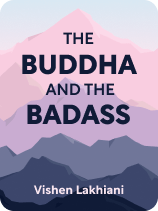

This article is an excerpt from the Shortform book guide to "The Buddha and the Badass" by Vishen Lakhiani. Shortform has the world's best summaries and analyses of books you should be reading.
Like this article? Sign up for a free trial here.
Do you want to discover who you truly are? How do you find your identity?
It can be hard to determine who we are, where we are, and what our purpose is. Luckily, Vishen Lakhiani’s book The Buddha and the Badass guides you through your self-discovery journey.
Learn how to find your identity by staying true to your values and your purpose.
Find Your Inner Identity: Your Values and Purpose
You can become spiritually enlightened and live a fulfilling life by understanding how to find your identity—what Lakhiani calls your soulprint (like a fingerprint but for your self). Your inner identity is made up of your values and your true purpose, writes Lakhiani. When you understand those aspects of yourself, you can live every day in alignment with them, which will give you the inner peace and contentment of enlightenment.
(Shortform note: In The Untethered Soul, Michael Singer adds that most people don’t understand their inner identities and the values and purpose that make them up. They therefore bounce between conflicting pursuits—perhaps one day feeling they should quit their jobs to pursue their passion for acting, and the next day feeling they should go to law school to have a respectable career. Understanding yourself, as Lakhiani recommends, can keep you from spending your life in this state of indecision.)
Values
Lakhiani writes that values are the beliefs you have that inform how you think and act, and these values are often shaped by big life experiences. The values you derive from your experiences are unique to you, and when you understand them, you can live by them.
He notes that challenging life experiences tend to shape your values more than pleasant or happy ones. For instance, you might be more affected by losing an important contest you’ve worked hard for than if you won that contest, and the experience might be more likely to lead you to develop values that shape your thinking thereafter.
(Shortform note: Lakhiani writes that values specifically grow from important life events. But others feel that your assimilation of values happens in your day-to-day life. For example, Tony Robbins argues that your values are shaped by your family, friends, school, and culture over the course of your life. Robbins’ view of values also clashes somewhat with Lakhiani’s because if your values are influenced by other people, they’re not really unique to you and aren’t deeply aligned with your inner identity. However, this could arguably make life easier for you because you don’t have to find people or jobs that are perfectly in sync with your unique values.)
Lakhiani stresses that we often let ourselves be influenced by societal values because we believe doing so makes us more significant in the eyes of others. If you feel others will be more impressed if you attain wealth and prestige than if you spend your time making experimental art, you may end up valuing wealth over creativity.
However, he advises that you don’t let the values of others become your values, as doing so will lead you down an unfulfilling and miserable path away from enlightenment. Stick to your own values instead. When you stop letting the opinions of others affect you and you see yourself as good enough as you are, you’ll have greater ease and more happiness in life.
(Shortform note: The tension between sticking to your values and wanting to fit in is something most humans have struggled with at some point in their lives. We all have an instinctive need to be accepted by others and indeed can’t help but be influenced, even on a neurological level, by the input of others. At the same time, we have a perhaps equally strong urge to be authentic and true to our needs and desires, despite what others may think of us. So how do we walk this line successfully? Perhaps the answer lies in being vulnerable. When we talk about our struggles with others, we encourage them to trust us because we’re not hiding anything. This trust allows us to do the things we want without fearing others will judge or spurn us.)
How to Determine Your Values
Lakhiani offers a way to determine what your true values are if you’re not sure of them:
- Pinpoint some terrible and some great moments in your life. Reflect on what you learned from those moments.
- Note as many values as you can that emerged from those moments.
- Group similar values together to create four categories.
- Determine what unites the values in those categories, and give those categories corresponding names.
- Once you’ve determined those four values, flesh out a short description of how those values inform your work and life.
| Changing Your Life Versus Changing Your Values Tony Robbins takes a different approach to living life according to your values. He doesn’t believe you should uncover your existing values to live life according to them, but rather that you should change your existing values to enable you to live the life you want. In other words, Lakhiani advises changing your life based on your values while Robbins recommends changing your values based on your ideal life. Robbins has also devised a five-step process for changing your existing values and value hierarchy to give you the life you want. Let’s look at the steps of both approaches and compare them. Step 1: Robbins writes that you must first pick the values you’d need to become the person you want to be in the future—his perspective is to the future. Lakhiani, on the other hand, suggests looking backward to find out which values have grown from your experiences. Step 2: Lakhiani says to write down all the values from your life experiences, but Robbins says to eliminate less critical values from your list. Robbins’ focus is more on prioritizing certain values while Lakhiani wants you to be sure you’re capturing all your values. Step 3: Lakhiani instructs you to group similar values into categories. Robbins instead asks you to create a hierarchical list of your values and assess how each value, and its place in your hierarchy, benefits you. It seems Lakhiani believes you can incorporate all values into your life while Robbins thinks you must prioritize them. Step 4: Robbins says to consider the downsides of prioritizing certain values over others. Lakhiani asks you to assign names to your value groupings. These steps don’t have much in common, but they continue to reinforce the authors’ different approaches to value-setting. Step 5: Robbins asks you to create a final hierarchical list of your values based on their priority. Lakhiani wants you to describe how your values influence your work and life. Lakhiani again is emphasizing the importance of existing values, while Robbins believes you must change your values and even order them to attain your ideal life. |
Purpose
Your values inform your life’s purpose—what the Universe wants you to do. Lakhiani advises that you stay aligned with that purpose and let it inform everything you do, and this will lead to you finding your identity.
He writes that your purpose often manifests as an intuition—an inner voice that nudges you in a certain direction—when you live according to your values. For example, based on your value of harmony and your love of science (which forms part of your inner identity), you might intuit your purpose is to use psychological research to help people be in greater harmony with each other. If you steadfastly follow this purpose, you’ll feel content in life.
(Shortform note: Lakhiani’s instructions on how to find your purpose are somewhat underdeveloped—he says you might intuit your purpose but doesn’t provide concrete actionables for how to find your purpose if your intuition fails you. Fortunately, other authors, like Simon Sinek, have written extensively about how to find your purpose. He advises you to compose a personal purpose statement, in which you articulate what impact you want to have on the world and the actions you’ll take to do that.)

———End of Preview———
Like what you just read? Read the rest of the world's best book summary and analysis of Vishen Lakhiani's "The Buddha and the Badass" at Shortform.
Here's what you'll find in our full The Buddha and the Badass summary:
- Why you don't need to work long, grueling hours to be successful
- How to transform your workplace from mundane to fun
- How to merge spiritual enlightenment with disruption






